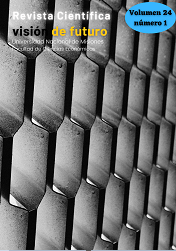Analysis of the integration of the management system based on the business architecture approach in Habana Libre hotel
Keywords:
Strategic Management; Enterprise Architecture; Integration of the Management System.Abstract
The problem of research lies in: How to help improve the strategic technological capability - based approach to Enterprise Architecture for system Integration Company? To solve the problem posed above is defined as General Objective: To apply the methodology of Strategic Management based approach to enterprise architecture for system integration business management (DEAE-ISDE) in the Habana Libre Hotel to contribute to integration of the steering system. For the development of the research tools such as: Checklist, Kendall's Concordance Coefficient, Diagram of Relations, Level of Integration of the Management System, among others. The main deficiencies were: the lack of an ICT that integrates the management of all indicators of efficiency and effectiveness, the lack of participation of the workers in the processes of changes, the lack of Integration of the activities of the strategic team because they do not have well defined the functions of each member, the low level of interoperability to automatically generate information from one application to another, deficiencies in strategic planning and the non-existence of a process for the management of technology surveillance. Eight improvement actions are proposed to eradicate the deficiencies found.References
Aguiar, L. (2015). Propuesta de una metodología para diagnosticar el estado de la gestión de la Infraestructura Tecnológica basado en el enfoque de Arquitectura Empresarial (Tesis de pregrado). Instituto Superior Politécnico José Antonio Echeverría, La Habana.
Alfonso, D. (2007). Modelo de dirección estratégica para la integración del Sistema de Dirección de la empresa (Tesis doctoral). Instituto Superior Politécnico José Antonio Echeverría, La Habana.
Arango, M. D., J. E. Londoño, y Zapata, J. A. (2010). Arquitectura Empresarial: Una visión general. Revista Ingenierías Universidad de Medellín, 9 (16).
Rouhani, B. D., Mahrin, M. N., Nikpay, F., Ahmad, R. B., y Nikfard, P. (2015). A systematic literature review on Enterprise Architecture Implementation Methodologies. Information and Software Technology, 62.
Bolaño, Y., Alfonso, D., Pérez, A., y Arias, M. (2014). Modelo de Dirección Estratégica basado en la Administración de Riesgos. Ingeniería Industrial, 35 (3).
Carbonell, L. (2011). Enfoque Estratégico para la integración del Sistema de Dirección de la Unidad Territorial de Inspección Estatal de la Construcción de Santiago de Cuba (Tesis de maestría). Instituto Superior Politécnico José Antonio Echevarría, La Habana.
Alfonso, D., Milanes, P. E., Villazón, A., Rodríguez, A., y Espín, R. (2011). Procedimiento general de rediseño organizacional para mejorar el enfoque a procesos. Ingeniería Industrial, 32 (3).
Malleuve, A., Alfonso, D., Stuart, M. L. (2015). Una aproximación hacia la evaluación del nivel de madurez de la arquitectura empresarial. Revista Cubana de Ingeniería, 6 (3).
Mikes, A., y Kaplan, R. S. (2015). When One Size Doesn’t Fit All: Evolving Directions in the Research and Practice of Enterprise Risk Management. Journal of Applied Corporate Finance, 27 (1).
Queris, M., Sánchez, J. M., y Manzano, M. (2014). Modelo de gestión de comunicación para la integración del sistema de dirección. Aplicación parcial en la compañía contratista de obras para la aviación (CCOA). Revista Colombiana de Ciencias Sociales, 5 (2).
Ortega, R. d. l. C. (2015). Propuesta de una metodología para diagnosticar el estado de la Gestión de la Información con enfoque de Arquitectura Empresarial. (Tesis de pregrado). Instituto Superior Politecnico Jose Antonio Hecheverria, La Habana.
Published
How to Cite
Issue
Section
License
Copyright (c) 2019 Laura Quintana Martínez, Sheila Anabela Corona Sánchez, Annette Malleuve Martínez
The works published in this magazine are under the Creative Commons Attribution-NonCommercial 2.5 Argentina license.
Important: The author is the owner of the rights to exploit the contents of the article of his authorship.
You are free to:
Share — copy and redistribute the material in any medium or format.
Adapt — remix, transform and build from the material.
The licensor cannot revoke these liberties as long as you follow the terms of the license.
Under the following terms:
Attribution - You must give appropriate credit, provide a link to the license, and indicate if any changes have been made. You may do so in any reasonable way, but not in a way that suggests that you or your use is endorsed by the licensor.
Non-Commercial - You may not use the material for commercial purposes.
There are no additional restrictions - You cannot apply legal terms or technological measures that legally restrict others to make any use permitted by the license.




















